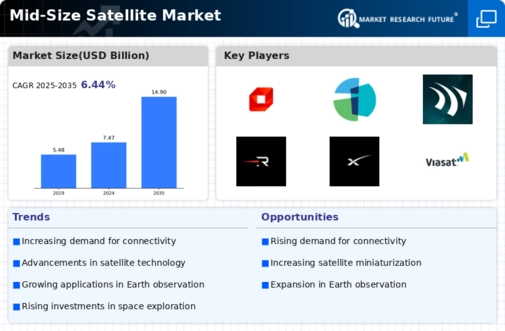Market Growth Projections
The Global Mid-Size Satellite Market Industry is poised for significant growth, with projections indicating a market size of 7.47 USD Billion in 2024 and an anticipated increase to 14.9 USD Billion by 2035. This growth trajectory reflects a compound annual growth rate of 6.47% from 2025 to 2035, underscoring the industry's potential. The increasing demand for satellite services across various sectors, coupled with advancements in technology and government initiatives, suggests a robust market environment. Stakeholders are likely to capitalize on these trends, driving further innovation and investment in mid-size satellite solutions.
Advancements in Satellite Technology
Technological advancements play a pivotal role in shaping the Global Mid-Size Satellite Market Industry. Innovations in miniaturization, propulsion systems, and payload capabilities enhance the performance and efficiency of mid-size satellites. These advancements enable operators to deploy satellites that are not only cost-effective but also capable of delivering high-quality services. As a result, the market is likely to witness a compound annual growth rate of 6.47% from 2025 to 2035. This growth is supported by ongoing research and development efforts aimed at improving satellite functionalities and reducing operational costs, thereby attracting new entrants into the market.
Government Investments and Initiatives
Government investments and initiatives significantly influence the Global Mid-Size Satellite Market Industry. Many countries are recognizing the strategic importance of satellite technology for national security, disaster management, and scientific research. For instance, various governments are allocating substantial budgets to develop and launch mid-size satellites, which enhances their capabilities in monitoring and communication. This trend is expected to contribute to the market's growth, with projections indicating a potential increase to 14.9 USD Billion by 2035. Such investments not only bolster domestic capabilities but also foster international collaborations, further expanding the market landscape.
Growing Applications in Earth Observation
The Global Mid-Size Satellite Market Industry is witnessing a growing interest in earth observation applications. Mid-size satellites are increasingly utilized for environmental monitoring, agriculture, and urban planning, providing critical data for decision-making. The ability to capture high-resolution imagery and real-time data enhances the effectiveness of these applications. As climate change and resource management become pressing global challenges, the demand for earth observation satellites is likely to rise. This trend suggests a promising future for the industry, as stakeholders seek to leverage satellite technology for sustainable development and informed policy-making.
Increasing Demand for Communication Services
The Global Mid-Size Satellite Market Industry experiences a surge in demand for communication services, driven by the need for reliable connectivity across various sectors. As businesses and governments increasingly rely on satellite communications for data transmission, the market is projected to reach 7.47 USD Billion in 2024. This growth is indicative of the expanding applications of mid-size satellites in telecommunications, broadcasting, and internet services. The proliferation of IoT devices and the need for seamless global communication further fuel this demand, suggesting a robust trajectory for the industry in the coming years.
Emerging Markets and Commercial Opportunities
Emerging markets present substantial commercial opportunities within the Global Mid-Size Satellite Market Industry. Countries in Asia, Africa, and Latin America are investing in satellite infrastructure to enhance connectivity and support economic growth. The increasing accessibility of satellite technology enables these regions to bridge the digital divide and improve communication services. As these markets develop, the demand for mid-size satellites is expected to grow, potentially leading to a market expansion that aligns with global trends. This shift may result in new partnerships and collaborations, further stimulating innovation and investment in the industry.





















